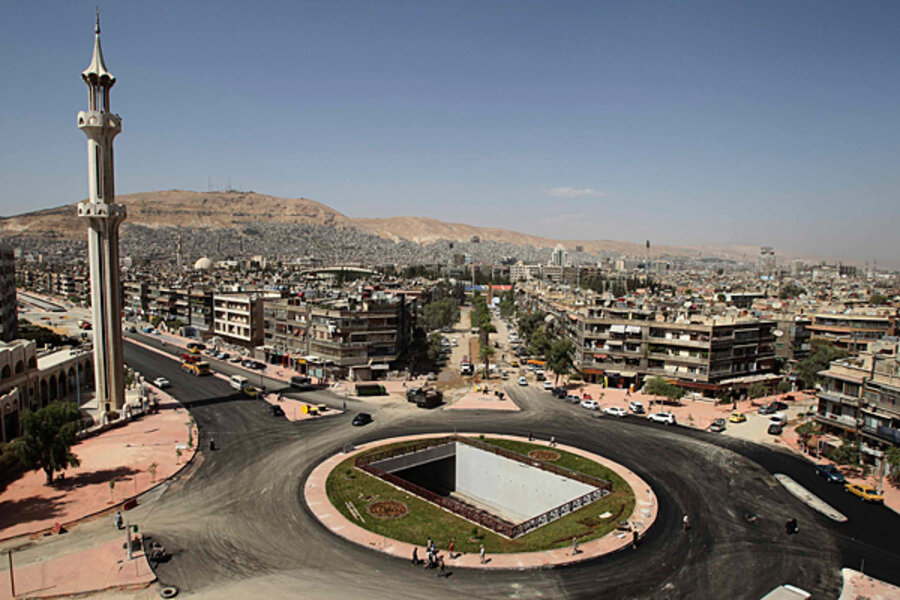Who wants to visit the Middle East? Twice as many people as in 2000.
| Damascus, Syria
When it comes to the Middle East, more than a few people might be surprised to learn of the region's latest achievement: stature as the fastest-growing tourism destination in the world.
Greater political stability and stepped-up efforts to attract visitors are at the root of the trend – one that not only tends to shore up regional stability and increase countries' revenues, analysts say, but can also give countries marred by allegations of corruption, human rights abuses, and autocracy a better image on the international stage.
“Tourism is an important new source of income for these countries and also provides jobs for local people,” says David Wilmsen, a professor at the American University of Beirut and longtime resident in the region. “But more important is the effect tourists can have on image improvement – something the Middle East desperately needs.”
So far this year, tourist arrivals to the region are up by 20 percent over last year – far greater than Europe's 2 percent increase and Asia's 6 percent growth, according to figures from UNWTO, the United Nations' World Tourism Organization. This is true despite the fact that UNWTO excludes the larger markets of Israel and Turkey from the region. (Editor's note: The original version misstated the region's growth rate in comparison to Europe and Asia.)
“We have witnessed far faster growth in the Middle East than we expected,” says Sandra Carvao of UNWTO. “In 2000, only 25 million tourists arrived compared to 130 million to the Americas. But just a decade later, the figure stands at 53 million.”
Specialist tours on religion, food, and history
Ms. Carvao attributes the rise to more intrepid travelers and increasing numbers of tourists from Asia, but also to the destination countries' efforts to promote their brand. Syria, Lebanon, Jordan, and the United Arab Emirates (UAE), inspired by the successful tourist industries of Israel, Turkey, and Egypt, have recently pushed hard to attract visitors – developing promotional campaigns, investing heavily in airports and roads, and attracting hotel chains such as the Four Seasons.
“Specialist religious, food, and history tours are also attracting people to come,” says May Mamarbachi, the owner of Damascus-based Beroia Travel that arranges trips in Syria, Lebanon, and Jordan.
A period of relative stability since 2006 as well as less sensitive travelers are also to thank. The ongoing lack of peace between Israel and the Palestinian territories, 9/11, flare-ups in Lebanon, and Syrian associations with non-state actors such as militant groups Hezbollah and Hamas have all been obstacles in the past.
The effects of the boom are being seen. Tourism receipts in the hit $41 million in the region last year, and provided a massive 36 percent of gross domestic product for Lebanon.
Syria: Top 10 destination for 2010
Syria is one country that is seeking both greater tourism revenues and the improved profile tourism provides. With an ailing economy in need of infrastructure investment and job creation, the country is also striving to rehabilitate its image, which hit a low point under the Bush administration, when it was characterized as a regional mischief-maker.
Syria has received rapturous coverage in the travel press lately, including a mention in The New York Times as at Top 10 destination for 2010.
Analysts argue that cultural exchange through tourism will also increase tolerance both in the region and the countries of the visitors.
But while UNWTO predicts the boom will continue, new visitors coming from outside the region – including Americans – could easily be deterred once again, say some. The result of the current round of Israeli-Palestinian peace talks may be key to perceptions.
“The Egyptian market was decimated after Muslim groups attacked tourists in Luxor in 1997, and this had a knock-on effect across the region,” says Mr. Wilmsen. “Governments will be keen to avoid turmoil, but with some tensions in the region, we have to wait and see what happens.”





